
This was meant to be a simple article to write: The story of VAP engines from the first cyclemotor units through to the last moped engines. Although the full story hasn't been published in English before, there are plenty of references for the different parts of the story, so it would be just a matter of bring the parts together ... wouldn't it?
However, it turns out that the previously published versions don't agree, particularly on the history of the earlier cyclemotors. There are two main versions of the story: one suggests that the first two versions were made during World War 2, the other claims that the first version didn't reach production numbers until the War was over.
ABG factory records don't survive and original manuals and brochures aren't dated. Enough motors survive to enable reasonable estimates of production numbers to be made and, most importantly, these show that the very first version was made in quite large numbers, at least 2,500 of them.
The Décret du 5 Juin 1943 seems to be the cause of the confusion. Passed by the Vichy government, this decree defined three legal categories of motor cycle: motocyclette, which was over 125cc; vélomoteur, between 50cc and 125cc; and bicyclette à moteur de secours (later called cyclomoteur), under 50cc. The VAP was bigger than 50cc, but this doesn't mean the change to a smaller capacity took place in 1943; passing a decree and putting it into force aren't the same thing. In fact, bicycle engines up to 58cc were still being exhibited at the Paris Salon of 1946. Manufacturing and selling hundreds of cyclemotor units in occupied Paris seems rather unlikely, so this is the version of events we've plumped for:
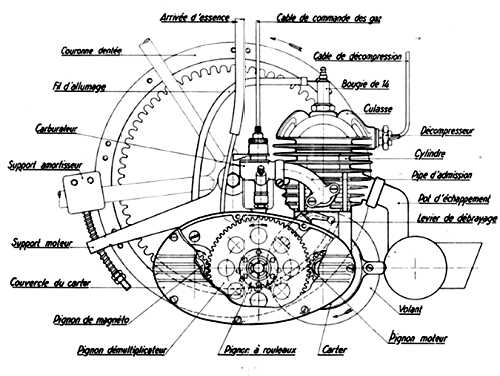
The first VAP cyclemotor was produced in 1942. Designed by Pierre Verots, it was a 53cc motor that mounted alongside the rear wheel of a bicycle and was built by La Bougie BG. The name VAP stands for Verots-Androit propulseur (Pierre Androit was the head of La Bougie BG). La Bougie BG became ABG following a merger with Ariès. ABG was in the Paris region - occupied France - not an ideal situation for making large numbers of cyclemotor engines. Therefore, it was not until the end of World War 2 that the VAP was put into production. Although production figures are not known, at least 2,500 of the original VAP motors were made as surviving engines fit in the engine number range of 1001 to 3500.
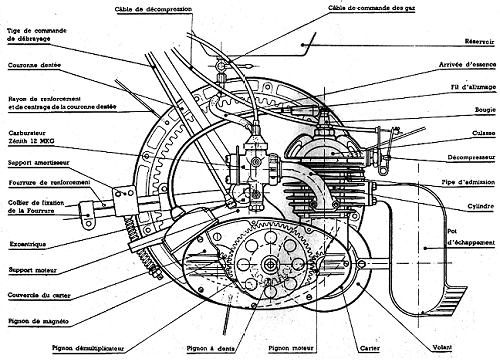
VAP 3 engine
The design rapidly evolved through two more models: the 51cc VAP 2 of 1946 and the 48cc VAP 3 of 1947. These engines are very similar, the capacity change being the significant difference between them. This change was made to keep abreast of French cyclomoteur legislation. Only a small number of VAP 2 engines was made - maybe as few as 500. Again, this figure is derived from surviving engine numbers, which suggest that VAP 2 started at number 5000 or 5001. From the VAP 2 through to the VAP 4, engine numbers 'ran through' in a continuous series so the VAP 3 starts around the 5500 mark and goes up to about 33000.
The VAP 4, introduced in 1948, saw some significant improvements. The final drive changed from a gear ring to chain drive, a flywheel magneto was introduced and it was equipped with a clutch. The VAP 4 cyclemotor remained in production until 1956 and is the most numerous of all the VAP cyclemotor engines. It is the most familiar version to us in the UK, not only because it was produced in many thousands, but also because it was imported and sold here.
While most VAP 4 engines were bought to motorise bicycles, there were some French manufacturers who offered complete VAP 4-powered machines. The most significant of these was Peugeot who produced the VAP 4-powered PHV 25 mixte cycle of 1949. Peugeot also made other VAP-engined machines like the Davy - a moped-style machine with a VAP 4 motor - and the Puma, which was sold in Belgium.
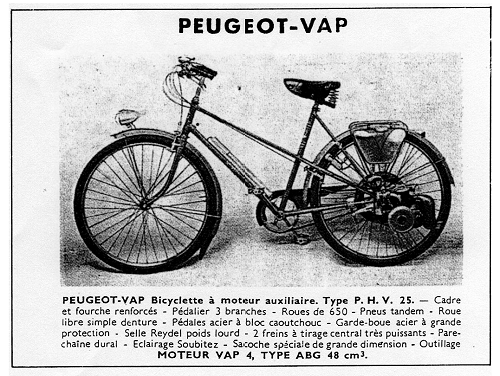
Peugeot PHV 25 with VAP 4 engine
The association with Peugeot led to the development of the VAP 5. This was a roller drive motor mounted under a cycle's bottom bracket. It was made exclusively for Peugeot during 1950 and powered the BMA 25L and BMA 25GL. The BMA 25 was marketed under several names, being branded as Aiglon, Automoto, Griffon, Météor, Peugeot or Trophée de France. These were only produced for one year, being replaced by the Peugeot Bima range in 1951. Engines for the Bima were produced from within the Peugeot group.
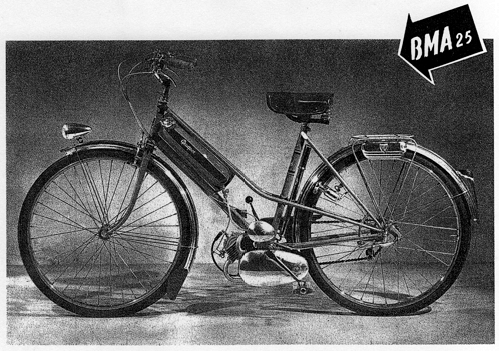
Peugeot BMA 25 with VAP 5 engine
So far, all VAP engines had been moteurs auxiliaires, or cyclemotor engines. A few manufacturers used the VAP 4 as a moped engine - for example, Peugeot's Davy which we've already mentioned. As the VAP 4 had a chain final drive, it would fit a moped frame quite well. 1952 saw the introduction of the first purpose-built VAP moteur adaptable or moped engine. The VAP 4/DT looked like a VAP 4 but with the exhaust moved to the front, and the carburetter to the back making it easier to fit into a moped frame. However, there were internal changes too, which increased its power to 1.75bhp. It had double transfer ports - hence the "DT" in its designation. Although the VAP 4 lasted to 1956, its cousin the VAP 4/DT was withdrawn in 1955, replaced by...
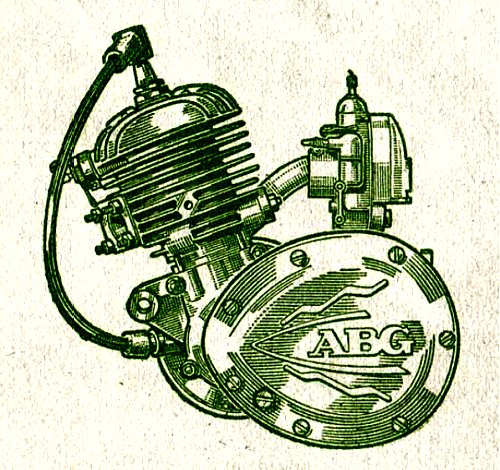
VAP A
In 1954 ABG introduced a new range of moped engines: the VAP A, VAP B and VAP G. The model letters aren't abbreviations of anything. They are derived from the company name: ABG. The VAP A was a simple, single-speed motor; the VAP B had a manual clutch and the VAP G had a two-speed gearbox. The VAP A was short-lived and only made during 1954. The VAP B continued in production until 1956 while the two-speed VAP G was available until 1958.
The VAP 5, VAP 4/DT and the A-B-G series of engines were unknown in the UK. However, in the next part of the story we will be on more familiar ground.
Last time we took the VAP story up to models A, B & G. Now we continue with model that will look more familiar to British readers.
The VAP 55 was introduced in 1955 - hence the model name. This was a Mobylette-style engine with a V-belt primary drive. It had an automatic centrifugal clutch. A version without a clutch was also made and this was designated VAP 55/3.
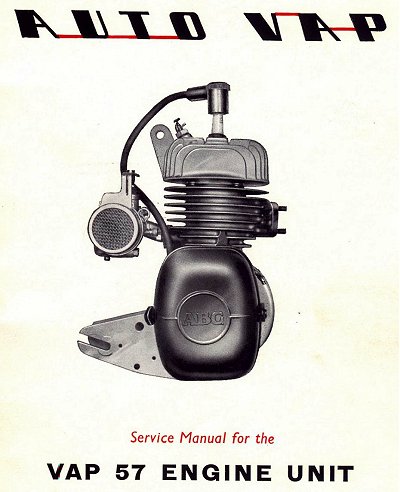
The VAP 57 and VAP 57/3, introduced in 1957, were the same as the VAP 55 and VAP 55/3 except thay had the Magnéclair ignition system instead of a flywheel magneto. The VAP 57 was in production until 1960. The VAP 57 was used in the UK: it was the engine used in the Auto-VAP mopeds sold by Scootamatic. Scootamatic had its origins in Elswick-Hopper and this is where the link to VAP starts, with VAP 57 engines being used to power the series of prototype mopeds that Elswick-Hopper produced.
With the enormous popularity of the Mobylette, automatic mopeds with V-belt primary transmission were far-and-away the dominant form in France. Other countries, like Germany, favoured the more streamlined two and three speed engines with built-in pedal shafts, as exemplified by Sachs and NSU Quickly engines. VAP introduced an engine of this type in 1959: the VAP Pi2 (Pédalier incorporé, 2-vitesses). It was not a commercial success and only lasted until 1960.
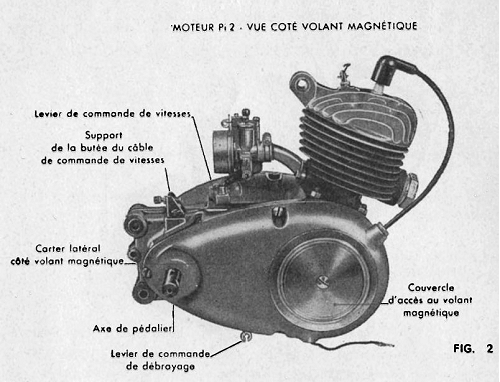
VAP Pi2
The last of the VAP moped engines was the VAP 610, introduced in 1961. This was an updated version of the VAP 57. The VAP 610 was replaced with the VAP 610R in 1962. The VAP 610R had a disc valve and a reduced power output - the reduction necessitated by changes in French legislation for cyclomoteurs. The VAP 610R was the last of the line and it remained in production until 1966.
There are two more VAP engines: The VAP 100 was a 110cc, kick-start engine with a three-speed gearbox for vélomoteurs, produced from 1956 until 1960. The other was the VéloVAP. This was a complete machine, very similar to the VéloSoleX and, like the VéloSoleX, had a roller-drive motor above the front wheel. In production from 1959 until 1969, the VéloVAP outlived all the other VAP engines, the later examples were made by Cazenave.
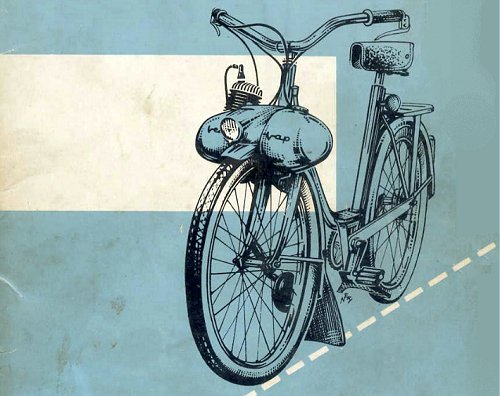
VéloVAP
First published in three parts The MAC between March 2011 and September 2011
Since publishing the above article, we have come across some picture showing the ABG-VAP factory. The pictures were taken in 1954 and the engines being made are the A, B and G types.
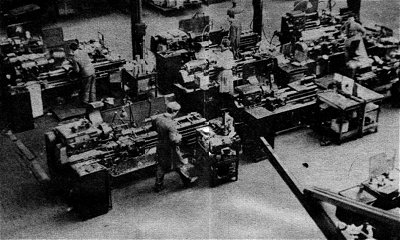
Automatic lathes on the factory floor
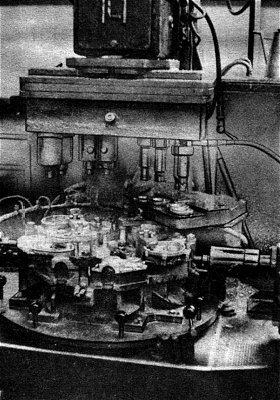
Crankcases being machined on a multi-spindle milling
machine.
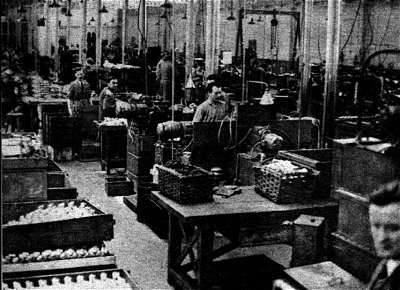
A view across the factory floor showing some of the
(then) modern machine tools installed to make the new range of
engines.
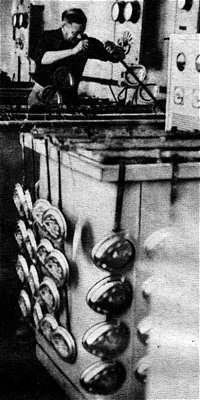
Chromium plating the primary transmission cover
plates.
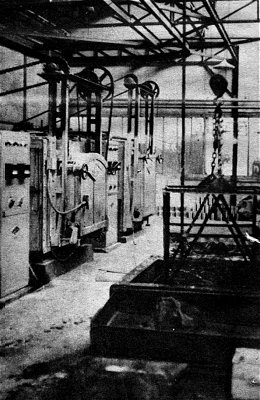
Ovens and quenching baths for heat-treating engine
components.
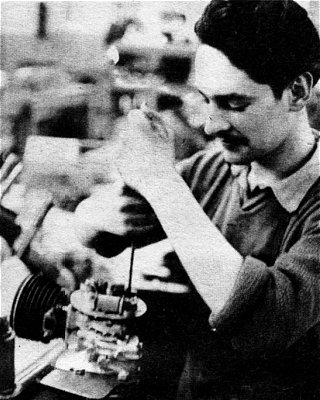
Engine assembly - here a magneto back-plate is being
fitted to the engine.
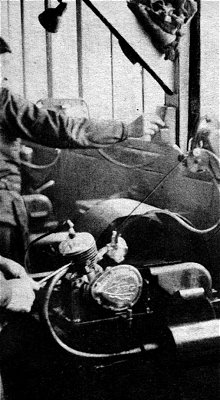
Testing a completed engine.
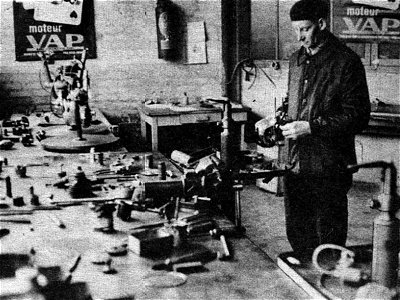
This workshop was not part of the production
process. It was used to demonstrate the construction and
maintenance of the engines to VAP agents.